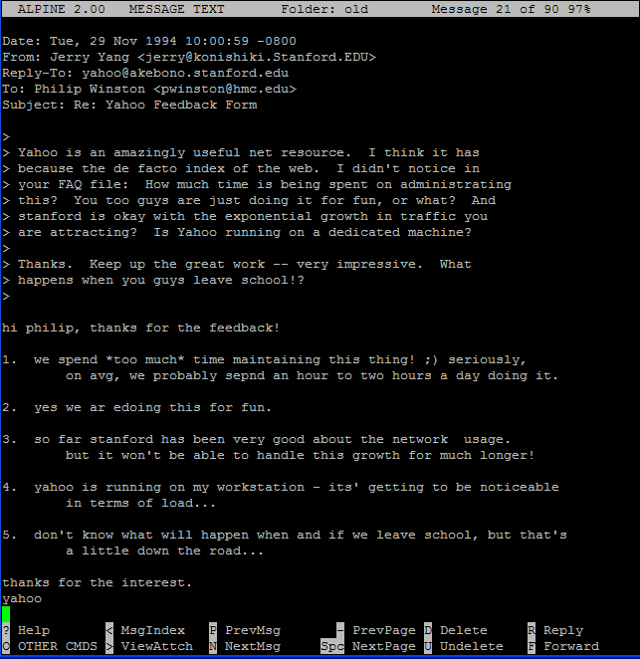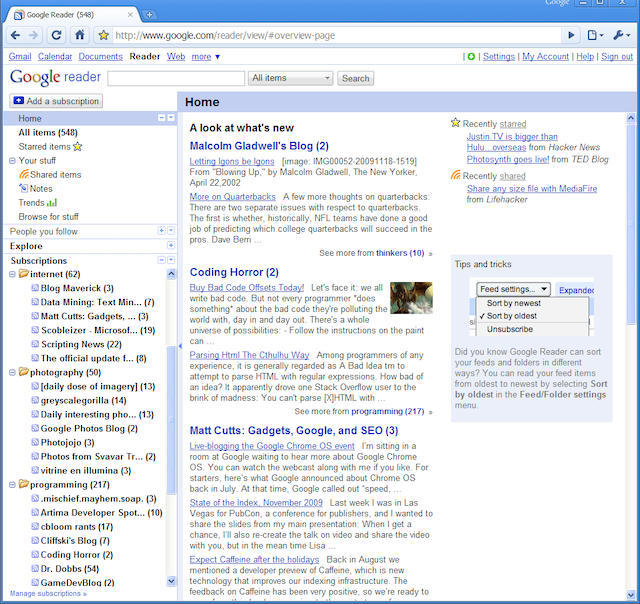Seeking What's New
I started taking the web seriously in the summer of 1994. Before that I had used the web, but I wasn’t quite sure what to make of it. That summer I had a job with Unisys in Kendall Square, Cambridge. They put me in a cold machine room and told me to learn about the web.
They didn’t even have an internet connection! I had to use my roommate’s university dial-up account. I downloaded whole copies of websites so I would have something to demo. I learned about browsers and HTML and web servers. At the end of the summer I gave a big presentation to the FAA folks who were Unisys’s customers. I told them yes, you should continue to look into this thing, it is going to be something.
Back at college I paid much closer attention to the web, and spent a lot more time online. I distinctly remember launching Netscape 0.9 for the first time. Netscape was free, but it was commercial software. It was incredibly slick. My first impression was watching it download 4 images at the same time. It was like magic, much faster and smoother than previous browsers. It felt like the beginning of something big.
It’s amazing the web made such an impression because the content at the time was minimal. A primary activity then, as now, was simply searching for new sites. There were various indexes and “what’s new” pages, but critical mass built around an index called Yahoo. It wasn’t a company yet, it was a side-project by two Stanford grad students. I once sheepishly sent them some kudos and questions through their “feedback form” and received a gracious reply from Jerry Yang, the co-founder and later CEO of Yahoo, shown below. It was a simpler time.

For a while it was possible to scan through everything on Yahoo’s “what’s new” page every day. By the end of 1994 you could no longer keep up. There were just too many sites. Fast forward to today and we find a staggering amount of new information coming online. YouTube says they receive hundreds of hours of new video content every minute. I’ve heard no similar figure on the number of new web pages, but surely it’s massive. No one can check out even a small fraction of them.
Two modern technologies for finding new information are RSS readers like Google Reader (shut down in 2013) and collaborative filtering sites like Digg, reddit, or my favorite Hacker News.
These two approaches work very differently. An RSS reader lets you “subscribe” to dozens or hundreds of websites and follow their ongoing updates from a single location. While collaborative filtering sites require no input ahead of time. Instead a community of users collectively generates an endless stream of new and interesting links you would never have found on your own.

So why all the emphasis on finding what’s new? Its seems obvious that we’d prefer new information to old, but it’s worth thinking about the reasons why. New information, entertainment or otherwise, is full of potential. You never know if that next article or YouTube video is going to be the coolest thing you’ve ever seen and the anticipation keeps you going. But why do we need to see what’s new right now? After all if we waited a while it would still be new to us. The reason is that new information has social value, and this value is time-critical.
It is far more exciting to see a movie on opening night than towards the end of its run or much later on DVD. This applies whether the movie is great or a horrible bomb. Part of this is the excitement of the crowd, the actual experience of watching, but the difference lasts long after the movie ends. As soon as you leave the theater you hold information which has significant value. People who haven’t seen the movie want to know if it was good, and people that have seen it want to talk about how great or horrible it was. Some of the excitement around the movie rubs off on you. This value fades over the coming weeks as new movies enter into our collective awareness.
This same social value applies to any media as well as all content on the internet. With the internet it’s even more pronounced because you can send interesting content directly to your friends. So not only do you hold valuable information, you can share it as well. Sharing high quality information is great for your credibility while forwarding stale sites will lower your stock.
So does social value alone explain our obsession about what’s new on the internet? The final piece comes to us from the world of neuroscience. They have found we have a hardwired “seeking” behavior, that our brains get into a state of “crazed excitement” and are continuously induced to seek more and more.
Web surfers trolling for new sites is just one type of seeking. Bargain shoppers flipping doggedly through rack after rack of clothes are under the same spell. Gamblers at the slot machine or blackjack table are desperately seeking a payout, even if the amount of money at stake is small.

So are we prone to seek anything? Could we get stuck in our front yard, seeking blades of grass? This doesn’t happen. The things we end up seeking do have genuine value. The new information, the discounted shirt, the money. Plus all three have social value. Bragging about your latest bargain or how much you won at the tables is a big part of the fun. What the neuroscience tells us is the brain magnifies this intrinsic value. It locks us into a feedback cycle where we seek with an intensity which is not really justified by what we are looking for.
So what is the future of “what’s new” on the internet? We know the desire for new information is very real and very deep seated. Each individual contributes some to the demand. With more and more users online the relative advantage of having newer or better information becomes larger over time. There is intense pressure to develop new technologies to better satisfy the demand. I don’t know what the technologies will be, but however good they are one thing is sure… we will still want more.